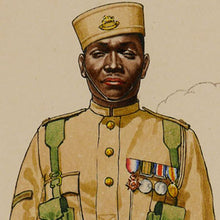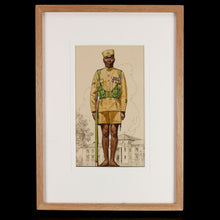British South Africa Police - Native Askari, 1937
Adding product to your cart
Overall: 43.5cm (17.2in) x 31.5cm (12.5in)
Watercolour on paper. A detailed original art work for one of the fifty John Player & Sons cigarette card series depicting 'Military Uniforms of the British Empire Overseas’. Image: 26cm (10in) x 14.5cm (5.7in).
Number 7 in the Player’s series, the card carried the collector’s album caption: - ‘The Native Police of Southern Rhodesia are recruited from the Matabele and Mashona tribes of the Colony, and from the adjoining territories of Nyasaland and Northern Rhodesia. Although forty years ago their ancestors were uncivilized, the present-day recruits reach a high standard of discipline and efficiency. They work in co-operation with European members in all branches of the Force, while a special platoon of Askari performs guard duties at Government House. The H.Q. and Training School are at Salisbury. During the Great War numbers of them saw service in German East Africa. The background shows the Municipal Offices, Salisbury, S. Rhodesia.’
As with many of the British Empire Overseas series, the present portrait possibly originated from Cattermole’s 1937 visit the Coronation contingents at Pirbright where he made detailed drawings and notes not just of uniforms but also of the likenesses of personnel. Thirty-one of these are held by the National Army Museum.
Lance Cattermole, ROI (1896-1992) was born in Ireland and was educated Odiham Grammar School before emigrating to Canada at eighteen. He was the grandson of George Cattermole (1800-68) who illustrated of the works of Dickens and Walter Scott. In April 1916 he returned to Europe as a member of the Canadian Expeditionary Force, and served on Western Front with 21st (Eastern Ontario) Battalion, first seeing action in the Battle of Flers–Courcelette during the 1916 Somme offensive. After the war he studied at Central School of Arts & Crafts, 1922-23, and at the Slade School, 1923-26. His first commercial work appears to have been posters for London County Council Tramways. In 1926 a Scots Guards officer commissioned him to produce a series of single figure uniform studies, which were subsequently reproduced as coloured and uncoloured etchings in various states. Cattermole’s original watercolours were seen by cigarette manufacturer John Player & Son of Nottingham at an exhibition at the Scots Guards R.H.Q. in London and led to the artist's commission by that company to produce the designs for the cigarette card series, 'Military Uniforms of the British Empire Overseas’. With the approach of the Second World War Cattermole’s talents were officially enlisted by the War Office to assist with the expansion of the T.A. - viz. 'Safeguard Your Liberties! Join the Territorial Army’ (1938). During and after the war he lived in the Sussex seaside town of Worthing with his wife (and poster model) Lydia who was secretary to the Sir Frederick Stern, the commander of the local Home Guard unit. Cattermole himself was a commissioned officer in the Home Guard and in 1940 executed his portrait of his brother-in-arms Percy Stanford, 5th Sussex (Worthing) Battalion, Home Guard, now in the N.A.M. https://collection.nam.ac.uk/detail.php?acc=1984-03-54-1. In the 1950s he produced iconic travel posters for the newly nationalised railways, including artwork for the Scottish Region series.






